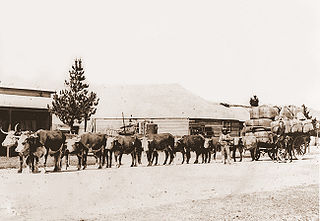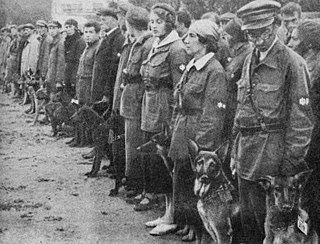
The German Shepherd, also known in Britain as an Alsatian, is a German breed of working dog of medium to large size. The breed was developed by Max von Stephanitz using various traditional German herding dogs from 1899.

A working dog is a dog used to perform practical tasks, as opposed to pet or companion dogs.

A police dog is a dog that is trained to assist police and other law enforcement officers, search and rescue, or the military. Their duties may include searching for drugs and explosives, locating missing people, finding crime scene evidence, protecting officers and other people, and attacking suspects who flee from officers. The breeds most commonly used by law enforcement are the German Shepherd, Belgian Malinois, Bloodhound, Dutch Shepherd, and Labrador Retriever. In recent years, the Belgian Malinois has become the leading choice for police and military work due to their intense drive, focus, agility, and smaller size, though German Shepherds remain the breed most associated with law enforcement.

The Belgian Shepherd is a breed of medium-sized herding dog from Belgium. While predominantly considered a single breed, it is bred in four distinct varieties based on coat type and colour; the long-haired black Groenendael, the rough-haired fawn Laekenois, the short-haired fawn Malinois, and the long-haired fawn Tervuren. In the United States, the American Kennel Club considers the four varieties to be separate breeds.

Dog training is a kind of animal training, the application of behavior analysis which uses the environmental events of antecedents and consequences to modify the dog behavior, either for it to assist in specific activities or undertake particular tasks, or for it to participate effectively in contemporary domestic life. While training dogs for specific roles dates back to Roman times at least, the training of dogs to be compatible household pets developed with suburbanization in the 1950s.

A detection dog or sniffer dog is a dog that is trained to use its senses to detect substances such as explosives, illegal drugs, wildlife scat, currency, blood, and contraband electronics such as illicit mobile phones. The sense most used by detection dogs is smell. Hunting dogs that search for game, and search and rescue dogs that work to find missing humans are generally not considered detection dogs but instead under their own categories. There is some overlap, as in the case of cadaver dogs, trained to search for human remains.


Military animals are trained animals that are used in warfare and other combat related activities. As working animals, different military animals serve different functions. Horses, elephants, camels, and other animals have been used for both transportation and mounted attack. Pigeons were used for communication and photographic espionage. Many other animals have been reportedly used in various specialized military functions, including rats and pigs. Dogs have long been employed in a wide variety of military purposes, more recently focusing on guarding and bomb detection, and along with dolphins and sea lions are in active use today.

A working animal is an animal, usually domesticated, that is kept by humans and trained to perform tasks instead of being slaughtered to harvest animal products. Some are used for their physical strength or for transportation, while others are service animals trained to execute certain specialized tasks. They may also be used for milking or herding. Some, at the end of their working lives, may also be used for meat or leather.

A search-and-rescue dog is one trained to find missing people after a natural or man-made disaster. The dogs detect human scent and have been known to find people under water, under snow, and under collapsed buildings.

Dogs in warfare have a very long history starting in ancient times. From being trained in combat, to their use as the scouts, sentries, messengers, mercy dogs, and trackers, their uses have been varied and some continue to exist in modern military usage.

Chips (1940–1946) was a trained sentry dog for United States Army, and reputedly the most decorated war dog from World War II. Chips was a German Shepherd-Collie-Malamute mix owned by Edward J. Wren of Pleasantville, New York. He was bred by C.C. Moore, and was the son of Margot Jute, a half collie, half German shepherd, and Husky, a malamute.

Anti-tank dogs were dogs taught to carry explosives to tanks, armored vehicles, and other military targets. They were intensively trained by the Soviet and Russian military forces between 1930 and 1946, and used from 1941 to 1943, against German tanks in World War II. Initially, dogs were trained to leave a timer-detonated bomb and retreat, but this routine was replaced by an impact-detonation procedure which killed the dog in the process.
Animal-borne bomb attacks are the use of animals as delivery systems for explosives. The explosives are strapped to a pack animal such as a horse, mule or donkey. The pack animal may be set off in a crowd.

Phu Cat Air Base Security Forces of the United States Air Force were Air Police and Security Police squadrons responsible for the air base ground defense of Phù Cát Air Base in South Vietnam during the Vietnam War.

Human–canine bonding is the relationship between dogs and humans. This relationship can be traced back to at least 15,000 years ago, to the Bonn-Oberkassel dog, who was found buried alongside two humans. For centuries, dogs have been considered man's best friend. This is most evident in western countries, such as the United States, where over 48% of households have a pet dog.
The War Dog Memorial was dedicated to the thousands of War Dogs that served during World War I, World War II, the Korean War, the Vietnam War, the Persian Gulf War, Bosnia, Iraq, and Afghanistan. The memorial also recognizes the service that War Dogs give to the United States of America on countless missions around the world for the Army, Navy, Air Force, Coast Guard, and Marines. The Memorial was dedicated September 16, 2006. Joseph Pavone, of Bristol Township, Pennsylvania, created the sculpture. The Memorial is located in front of the Bristol Township Municipal Building located at 2501 Bath Road, Bristol, PA, 19007.

The National War Dog Cemetery is a memorial to war dogs located at Naval Base Guam and is the first official war dog monument in the U.S. The cemetery honors the dogs—mostly Doberman Pinschers—that were killed in service with the United States Marine Corps during the Second Battle of Guam in 1944.

A mercy dog was a dog that served in a paramedical role in the military, most notably during World War I. They were often sent out after large battles, where they would seek out wounded soldiers; and trench warfare suited their use. They carried first-aid supplies that could then be used by wounded soldiers, and comforted dying soldiers who were mortally wounded. They were also trained to guide combat medics to soldiers who required extensive care. Many mercy dogs were trained by national Red Cross societies to serve the country in which the specific society operated. The German army called such dogs medical dogs. As many as 20,000 dogs are estimated to have served as mercy dogs in World War I and World War II, and they have been credited with saving thousands of lives. Such dogs were also used by the United States in the Korean War.

In law enforcement work, Police dogs are used worldwide for a variety of purposes that include apprehension, detection, and search and rescue.



















